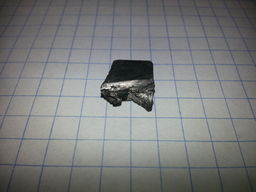Difference between revisions of "Terbium"
| Line 1: | Line 1: | ||
[[File:Terbium_by_Brain&Force.jpg|thumb|256px|5.74 grams of distilled terbium metal]] | [[File:Terbium_by_Brain&Force.jpg|thumb|256px|5.74 grams of distilled terbium metal]] | ||
| − | '''Terbium''' is a [[lanthanide]] with the symbol Tb and atomic number 65. It is a hard, dark, silvery metal that is about as reactive as [[magnesium]]. Although difficult to find and rather expensive, it and its salts have very interesting properties that make it an excellent addition to the amateur chemist's lab. Among these properties are [[fluorescence]] and [[paramagnetism]], brought about by the element's half-filled f-shell. | + | '''Terbium''' is a [[lanthanide]] with the symbol '''Tb''' and atomic number 65. It is a hard, dark, silvery metal that is about as reactive as [[magnesium]]. Although difficult to find and rather expensive, it and its salts have very interesting properties that make it an excellent addition to the amateur chemist's lab. Among these properties are [[fluorescence]] and [[paramagnetism]], brought about by the element's half-filled f-shell. |
==Properties== | ==Properties== | ||
Revision as of 17:26, 7 August 2017
Terbium is a lanthanide with the symbol Tb and atomic number 65. It is a hard, dark, silvery metal that is about as reactive as magnesium. Although difficult to find and rather expensive, it and its salts have very interesting properties that make it an excellent addition to the amateur chemist's lab. Among these properties are fluorescence and paramagnetism, brought about by the element's half-filled f-shell.
Contents
Properties
Physical properties
Terbium is a dark silvery metal that is solid at room temperature. It is quite resistant to impact, but can be scratched with a knife or file.
At room temperature, terbium is paramagnetic and can be picked up easily with a neodymium magnet. This paramagnetism turns to antiferromagnetism at 230 K and to ferromagnetism at 219 K, which is above the temperature of dry ice. This causes a noticeable incrase in magnetic attraction. Terbium has the second-highest Curie temperature of the rare earth elements, exceeded only by gadolinium.
Terbium(III) cations fluoresce to produce bright green light. The fluorescence is generally only visible in the solid state, but certain ligands will allow solutions of these salts to fluoresce in solution. These ions are also paramagnetic, and compounds of terbium(III) may be lifted by a powerful magnet.
Chemical properties
Although terbium is a highly electropositive element, the metal can be stored indefinitely in air and does not corrode, even after years of exposure. However, terbium reacts slowly in cold water, and vigorously in hot water and dilute acids to form trivalent salts.
Terbium reacts with all of the halogens to form trihalides. Small pieces can burn in air with a golden flame to form terbium(III,IV) oxide, which is black, and markedly different from terbium(III) oxide.
In nitric acid, terbium metal will oxidize to both terbium(III) nitrate, which remains in solution, and terbium(III,IV) oxide, which settles to the bottom as a black precipitate.
Terbium sulfate is only poorly soluble in water, and its solubility decreases as temperature increases. Double sulfates with sodium and potassium are even less soluble. Terbium oxalate is extremely insoluble in water.
Terbium(III) is the most stable oxidation state of the element. It is very highly fluorescent. It is not amphoteric, and adding bases such as ammonia to terbium-containing solutions will produce a precipitate of white terbium hydroxide. This hydroxide is itself basic, and will absorb carbon dioxide to form terbium carbonate. This change is not very noticeable.
Terbium(IV) compounds are highly oxidizing. Terbium(III,IV) oxide is a black powder which is similar to manganese dioxide. It can be prepared by igniting terbium(III) oxalate. It is also an excellent catalyst. Terbium(IV) fluoride is one of the best fluorinating agents known, due to its ability to emit relatively pure atomic fluorine, rather than fluoride vapors.
Availability
Terbium is more common than iodine on Earth, but it is very hard to find and expensive. It is also one of the rarest lanthanides, and is in high demand due to its numerous applications. One source for terbium, as well as other rare earth metals, is Metallium. It is sold in 5 gram and 20 gram sizes, as well as rods, ampoules, and coins. Terbium and its compounds occasionally sold on eBay as well.
Projects
- Making magnetic and fluorescent crystals
- Making triboluminescent crystals of hexakis(antipyrine)terbium(III) iodide
- Demonstrating fluorescence enhancement
- Demonstrating the Curie point and the Néel point
Storage and safety
Storage
While there is no problem with storing terbium under an inert argon atmosphere or under mineral oil, terbium does not corrode easily and there is no problem with leaving it in air indefinitely. The pure metal is not affected by the hand moisture when handled without protection.
Toxicity
Toxicity data of terbium compounds is scarce, but they appear to be of low to moderate danger. Terbium plays no biological role, but acts similarly to calcium within the body. Some terbium compounds, notably the halides, will hydrolyze when heated and will give off acidic vapors.
Flammability
Small pieces of terbium metal or terbium powder are flammable. Class D fire extinguishers should be readily available when working with terbium near an open flame. Water should never be used to extinguish burning terbium, as it will aggravate the flame.
